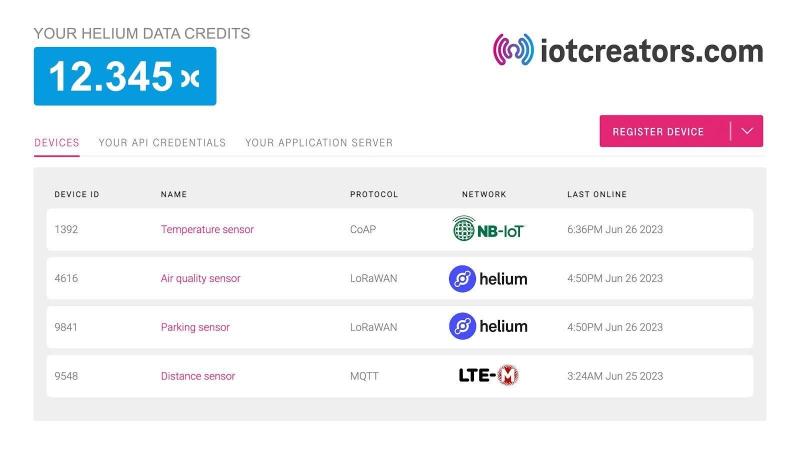Deutsche Telekom built IoT Creators as a platform to support various IoT networks, and it’s now adding the Helium IoT network to the equation.
Specifically, IoT Creators will offer an integrated Helium LoRaWAN Network Server (LNS) in its platform to encourage users to onboard and manage devices on the Helium Network.
According to the companies, the IoT Creators platform brings flexibility to sensor deployers by allowing smart devices to be wireless agnostic; devices can leverage both LoRaWAN and cellular networks depending on the user’s needs. Using the managed iotcreators.com LNS, users can get access to one interface to manage devices that can run across LoRaWAN, NB-IoT and LTE-M.

It’s one way to tackle the fragmentation that has permeated the IoT world.
“The Helium Network has become a key connectivity option for IoT developers and solution providers,” said Afzal Mangal, founder of IoT Creators at Deutsche Telekom, in a statement. “Our collaboration with Helium is another step to proactively integrate various technologies so that customers can obtain an end-to-end service from a single source.”
Validation from DT

For Helium, the deal with DT is welcome validation that a leading telecom company like DT wants to invest in the Helium ecosystem, according to Helium Foundation CEO Abhay Kumar. It’s not a commercial agreement per se where they’re exchanging money, but this will enable more traffic for Helium, he said.
Helium Foundation is a designated non-profit organization in the U.S. that operates like a trade association. It gets grants to help with its funding needs, according to Kumar. But long term, the revenue plan is through a membership program model, which is still in the works, he said.
Helium Foundation pays its employees, which number around 27, with local currency, while its claim to fame is tied to the cryptocurrency that it supports through the Helium network.
Helium’s original focus was on IoT and smart devices and in 2019, it launched blockchain as a way of incentivizing and supporting the IoT network. The idea is that anybody should be able to buy a hotspot device, install it in a home or office and provide coverage for smart devices passing by the facility. In return, these individuals are rewarded in cryptocurrency.
Helium’s IoT network now has about 500,000 active hotspots, providing coverage across 77,800 cities in more than 192 countries, and it’s considered the world’s largest LoRaWAN network. Helium’s cellular network is much smaller, but in less than a year, it’s grown to more than 8,610 radios, providing lower cost cellular coverage across more than 1,637 cities in the U.S., according to the company. The cellular network uses Citizens Broadband Radio Service (CBRS) spectrum.
Switch to Solana
Until earlier this year, Helium was using its home-grown blockchain architecture. That meant it was trying to build a network and operate a blockchain at the same time, so it decided to migrate to the Solana blockchain.
For most folks in Helium’s sphere, it was a fairly simple transition, in part due to the time spent in preparation. In fact, there was a short delay leading up to transition day because they wanted to make sure everything was going to work as advertised, according to Kumar.
Some users voiced concerns about the switch to Solana being disruptive. “Any change like this, it’s fair to be apprehensive,” Kumar told Fierce. “It’s a pretty large change,” and people are understandably going to question whether it’s going to work well. “It’s reasonable to have that question. Obviously, we spent a long time building tools to make that migration very easy.”
Now Helium can put all its attention on building a wireless network, he said.
What’s next for the DeWi networks
The Helium IoT network and the Helium Cellular network each have their own set of rules, and if there’s another Helium data network down the line, it also will have its own set of rules, he said. The goal for the Helium Network is to become a Network of Networks, serving all types of wireless protocols, from LoRaWAN to cellular to VPN, Wi-Fi and more.
The thing about the cellular network is usage will drive deployments and deployments will drive usage and it will kind of go back and forth, and “that pendulum shift is exactly what we want to see,” he said.
“Our perspective on it is building decentralized wireless networks is sort of a new and alternative way to get coverage to everyone,” he said. “That’s our take. We believe in wireless networks, and we believe that the way to build them is in a decentralized way.”
So if this were a baseball game, which inning is Helium in? “We’re warming up,” he said. “It’s all still so early. Especially on the cellular side, we’re definitely warming up. On the IoT side, we’re kind of like – fourth inning, maybe? It’s established a little bit, but we still have plenty of room to run.”